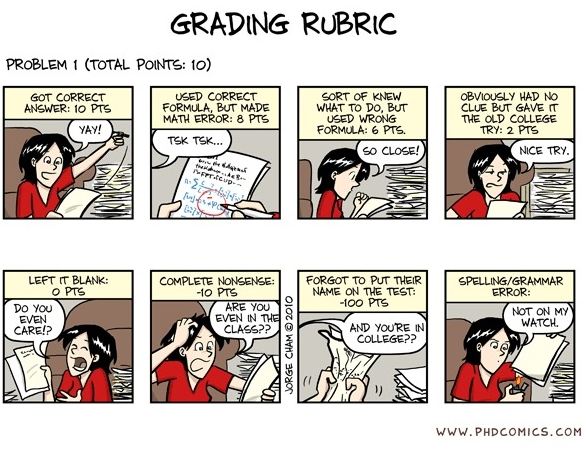A rubric is typically an evaluation tool or set of guidelines used to promote the consistent application of learning expectations, learning objectives, or learning standards in the classroom, or to measure their attainment against a consistent set of criteria. In instructional settings, rubrics clearly define academic expectations for students and help to ensure consistency in the evaluation of academic work from student to student, assignment to assignment, or course to course. Rubrics are also used as scoring instruments to determine grades or the degree to which learning standards have been demonstrated or attained by students.
In courses, rubrics may be provided and explained to students before they begin an assignment to ensure that learning expectations have been clearly communicated to and understood by students, and, by extension, parents or other adults involved in supporting a student’s education. Rubrics may take many forms, but they typically include the following information:
- The educational purpose of an assignment, the rationale behind it, or how it connects to larger concepts or themes in a course.
- The specific criteria or learning objectives that students must show proficiency in to successfully complete an assignment or meet expected standards. An oral-presentation rubric, for example, will establish the criteria—e.g., speak clearly, make eye contact, or include a description of the main characters, setting, and plot—on which students will be graded.
- The specific quality standards the teacher will use when evaluating, scoring, or grading an assignment. For example, if the teacher is grading an assignment on a scale of 1 to 4, the rubric may detail what students need to do or demonstrate to earn a 1, 2, 3, or 4. Other rubrics will use descriptive language—does not meet, partially meets, meets, or exceeds the standard, for example—instead of a numerical score.
Rubrics are generally designed to be simple, explicit, and easily understood. Rubrics may help students see connections between learning (what will be taught) andassessment (what will be evaluated) by making the feedback they receive from teachers clearer, more detailed, and more useful in terms of identifying and communicating what students have learned or what they may still need to learn. Educators may use rubrics midway through an assignment to help students assess what they still need to do or demonstrate before submitting a final product. Rubrics may also encourage students to reflect on their own learning progress and help teachers to tailor instruction, academic support, or future assignments to address distinct learning needs or learning gaps. In some cases, students are involved in the co-creation of rubrics for a class project or for the purposes of evaluating their own work or that of their peers.
Since rubrics are used to establish a consistent set of learning expectations that all students need to demonstrate, they may also be used by school leaders and teachers as a way to maintain consistency and objectivity when teaching or assessing learning across grade levels, courses, or assignments. While some schools give individual teachers the discretion to create and use their own rubrics, other schools utilize “common rubrics” or “common assessments” to promote greater consistency in the application and evaluation of learning throughout a school. In most cases, common rubrics are collaboratively developed by a school faculty, academic department, orteam. Some schools have common rubrics for academic subjects, while in other schools the rubrics are utilized across all the academic disciplines. Common rubrics and assessments can also help schools, departments, and teaching teams refine their lessons and instructional practices to target specific learning areas in which their students tend to struggle. Rubrics are often locally designed by a district or school, but they may be provided by outside organizations as part of a specific program or improvement model.
Above article is reproduced herein by the kind courtesy of “The Glossary of Education Reform by Great Schools Partnership”

